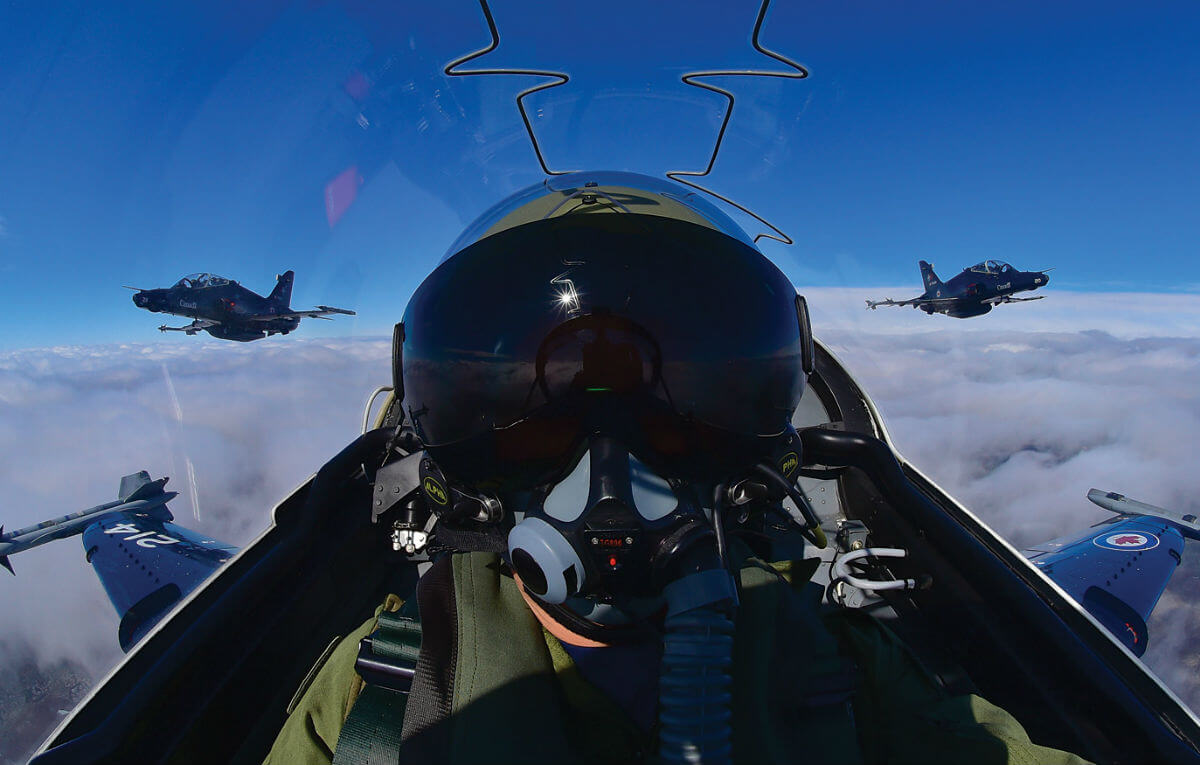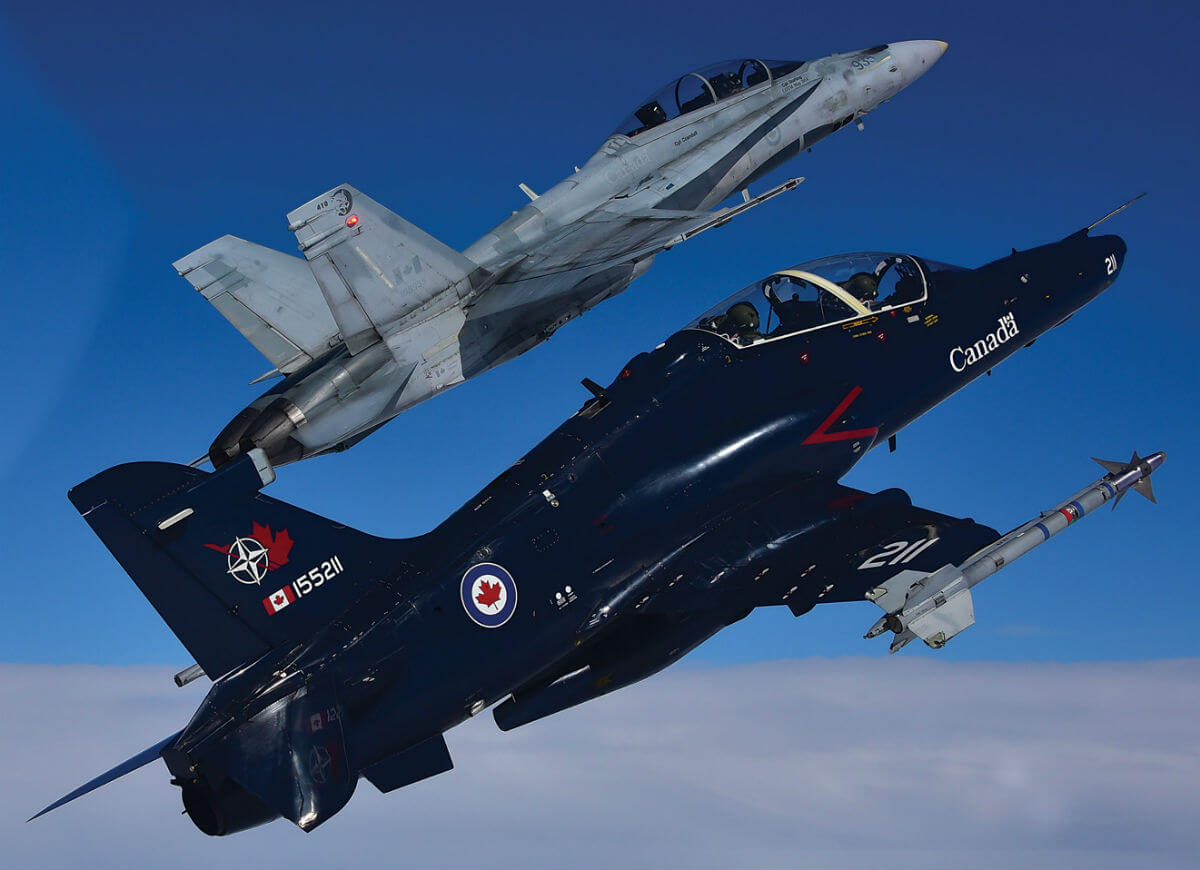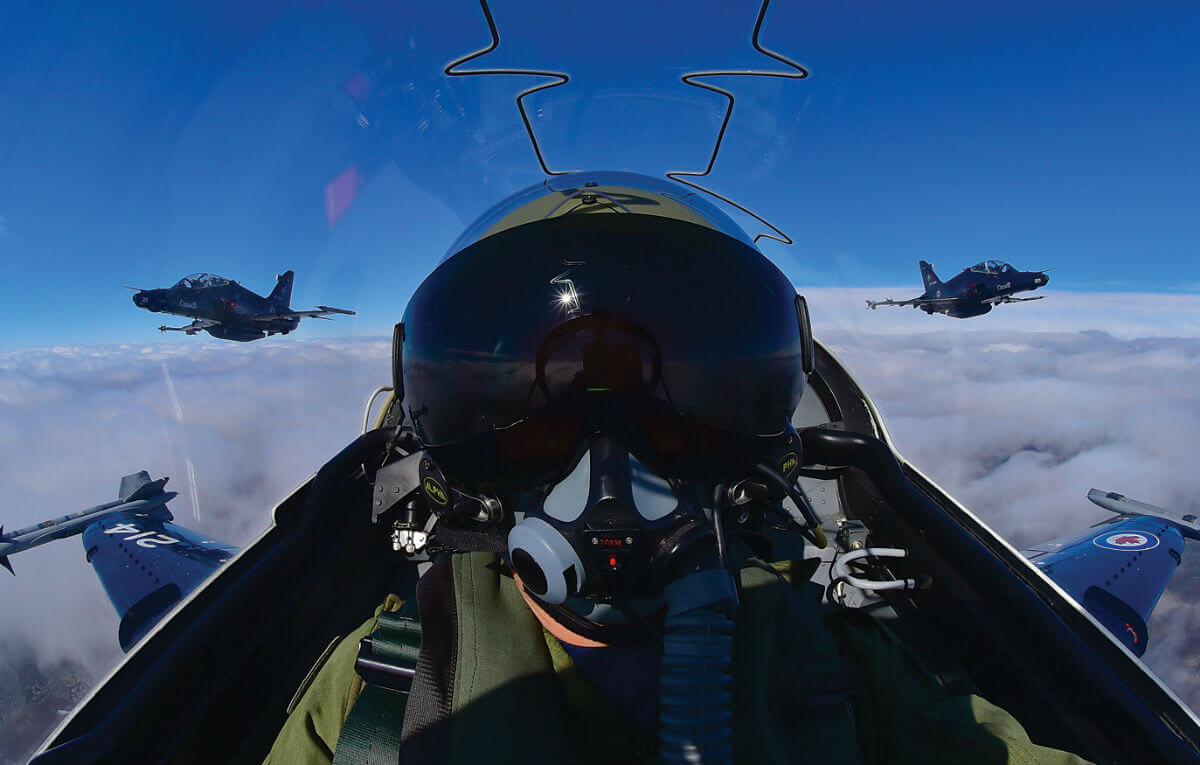Estimated reading time 6 minutes, 33 seconds.
Ask Capt Thegne Rathbone about becoming a fighter pilot and you can feel his excitement. For one, the smile rarely leaves his face.

“I have it within fingertip reach,” he said. “I’ve got eight months of training left and then I can call myself a fighter pilot.”
Sitting in a small conference room at 419 Tactical Fighter Training Squadron, Rathbone is no more than a short walk across the runway from 410 Tactical Fighter (Operational Training) Squadron at 4 Wing Cold Lake, the introductory step into a CF-188 Hornet and the final stop in a lengthy but rewarding training process before being assigned to an operational fighter squadron.
“The F-18 is a twin-engine, after-burning, munitions dropping aircraft–what more do you want to give a 25-year-old to play with?” he asked as he opened his logbook to Skies for a brief look at his journey to jet fighter status.
Maybe it’s the movies, maybe it’s a family member, or maybe it’s just an early fascination with flying. But regardless of how young pilots come to crave the thrill, it’s a pull that often proves irresistible.
Becoming a fighter pilot in the Royal Canadian Air Force, however, is not for the impatient.
Although Rathbone arrived at this point in his eight years with the RCAF about as quickly as any prospective pilot could, the training process is the longest and most challenging of all of the pilot training programs, involving over 400 flying hours and more than 180 hours in a simulator.
Until the fall of 2015, he had shot through the four phases of the development program with barely a few days or weeks between each. But with operations over Iraq and Syria pulling many CF-188 instructor pilots away from training and limiting the number of aircraft available for students, as well as changes to manning requirements at 401 and 409 Tactical Fighter Squadrons as they undergo a division into two distinct units, Rathbone found himself in a holding pattern.
A self-confessed “flying mooch” who jumped into extra flights, even in the backseat, at every opportunity, he has continued to absorb as much as he can from the veteran instructor pilots at 419 Squadron as he awaits the call.
And it’s a move that can’t come soon enough. Becoming a pilot has been a dream since an early age. Rathbone joined the military in July 2008 at the age of 18 and, over the next four years, completed basic training and earned a Bachelor’s degree in aeronautical engineering from the Royal Military College in Kingston.
From there it was off to 3 Canadian Forces Flying Training School in Portage la Prairie, Man., for the first phase of pilot training. Rathbone took his preliminary flight in the fall of 2012 on the Grob 120-A, an elementary trainer operated by Allied Wings under the Contracted Flight Training and Support Program.
Over three months, he flew 16.8 hours in the small prop plane, more than the course syllabus of 12, by nabbing extra flights whenever weather delayed the training.
By January 2013, he had landed at 2 Canadian Forces Flying Training School in Moose Jaw, Sask., for phase two, also known as the first phase of NATO Flying Training in Canada (NFTC), a three-part program that begins by sorting the fighter pilots from their multi-engine and helicopter colleagues. Many may arrive with ambitions for one aircraft, but within months it is often apparent where they will fit best, Rathbone observed.
For him, the thrill of his solo proficiency check on the CT-156 Harvard II turboprop was a memorable moment.
“They gave me a 1,100 shaft horsepower aircraft, fully aerobatic, to go play with,” he said, amazed that he was flying solo with just 34 hours of military flying time. “That gets the adrenaline going.”
The 70 flying-hour course, which includes about 40 hours in the simulator, takes pilots through “clearhood” or basic aircraft handling, instrument flying, low-level navigation (240 knots at 200 feet) and formation flying. “It is nerve wracking at first being that close,” he said, “but it is very rewarding once it clicks.”
With 97 flight hours under his belt, Rathbone was selected to the jet fighter program and just a week later, in September 2013, he entered phase three (phase two of NFTC).
The four-month course of 80 flying hours (plus 17 in the simulator), still on the CT-156 Harvard II in Moose Jaw, follows a similar but more advanced syllabus to phase two, introducing composite missions that integrate the specific aspects of the previous course into a single flight.
On Jan. 20, 2014, a day he recalls with some pride, Rathbone received his pilot’s wings. It was barely 15 months since he’d entered pilot training, but he now had 178 hours of military flying time and was keen to move ahead.

A few weeks later, he was settling into the cockpit of a CT-155 Hawk. The three-month transition course in Moose Jaw qualifies students in the jet-engine aircraft before they make the flight north to 4 Wing Cold Lake, Alta., and phase four, the fighter lead-in training (FLIT) program at 419 Squadron.
“You do all the same basic manoeuvres you did in phase two, but now you are doing it on a jet and you are expected to learn in a much shorter time frame,” Rathbone said. “That was the first jet aircraft experience ever, and that’s fun.”
With 247 flying hours in his logbook, 55 on the Hawk, he began “the best course I have ever been on and one of the most fun times of my life.”
Phase four, a five-month course that upped the ante in every aspect of his flying, gradually turned into a 10-month program as dismal weather wiped away most of December, January and February. But by May 2015, Rathbone had accumulated the necessary flying hours (94 in his case and 32 in the simulator) to pass.
He now had 347 hours and was itching to fly the CF-188 Hornet. But 410 Squadron wasn’t ready.
While waiting, he has “mooched” his way onto training flights and was among the first students to go through a tactical refresher course, a new program designed to keep future fighter pilots proficient in tactical procedures.
“They were non-graded missions, so you were treated more as an adult pilot, less as a student,” he explained. “The shots were yours to call in the air. I learned a lot on that refresher course.”
He has also made good use of the simulator, though he’s quick to caution that while it’s “a great tool, sims can never replace actual flying time in an aircraft.”
If the aim of the pilot training program, and especially the FLIT course, is to instill basic fighter skills and hone core competencies such as situational awareness and decision-making in dynamic environments, Rathbone believes the program has prepared him well. The training program at 410 Squadron may be another 60 flight hours, but that’s the final reward.
“I feel comfortable going into 410,” he said. “There is always that little excitement and nerves of a new aircraft. It has been a lot of long days, but they prepare you well. It’s a rewarding experience all through.”
This story originally appeared in the September/October issue of Skies.
Chris Thatcher is a freelance writer specializing in defence, security and technology issues.

